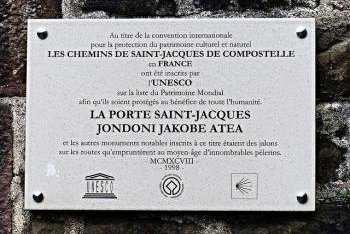Clyde 2.0
Routes of Santiago de Compostela in France
Routes of Santiago de Compostela in France (Inscribed)

I had already visited several parts of this WHS by car (some of which are inscribed twice). This year however I arrived in Bayonne by bus from Biarritz and since I had some time to spare before catching the next train to St Jean Pied de Port, I decided to wander about and explore Bayonne first. Although I was going to start my pilgrimage to Santiago from St Jean, I asked for some info at the pilgrims' welcome desk inside the cathedral and since I quite liked the cathedral and the warm welcome I received, I also decided to stamp my credencial for the first time here. However, although I wore the pilgrim shell on my backpack and although there were quite a few other pilgrims passing by, no local greeted me with a "Bon Chemin" as was the case in practically all the other villages, towns and cities I had visited in the previous years. My gut feeling is that nowadays the route of Santiago de Compostela in France is no longer "alive" amongst the locals. Some if not most aren't even aware that a given town or village is right on the camino/chemin. It's as if it is merely a tourist label to attract tourists. Yet it is not why most tourists visit so it's not given much importance. The only exception to this is of course St Jean Pied de Port which lies at the base of the Roncevaux Pass across the Pyrenees. The routes from Paris, Vézelay and Le Puy-en-Velay meet at St Jean Pied de Port and it is the pilgrims' last stop before the arduous mountain crossing. Nowadays, it is mostly visited by pilgrims who start their pilgrimage from here. Numbers are steadily increasing and from April to November, when the pass is open, you will most definitely have more pilgrims roaming about than locals. From a quick glance at the statistics in the pilgrims' welcome office, numbers have really soared from a couple of hundreds visiting St Jean in 1996 to several thousands in 2015. According to their statistics, pilgrims who start their camino in St Jean are mostly French, followed by Americans, Spaniards, Italians, German, Koreans, Dutch and Brazilians. This was more or less reflected in the camino as those nationalities were pretty much always present in every other albergue, monastery or cathedral. The main highlight of St Jean are the fortifications and of course the Porte de St Jacques which marks the first step of an 800km journey to Santiago de Compostela for so many pilgrims. There you can find the Unesco plaque (picture) too. Since the first 23km are uphill all the way except for a sharp descent to Roncesvalles, I decided to stop at the only refuge half way up and take it easy. It really turned out to be a wise decision as upon arrival in Roncesvalles the day after, other pilgrims I had met told me that it had rained the whole afternoon and morning, so not only did I luckily avoid the wet weather but most importantly I suffered no serious injuries along the way. Most pilgrims I met in the days to come and who had to stop because of an injury, all said that the first day of walking was quite a killer. The views of the mountains along this final part of the Route are fabulous especially at sunset/sunrise and towards the end of April not only the peaks were covered with snow but there were also some parts of the route which were still covered with snow (which became ice at temperatures close to 0 at daytime - something to keep in mind!). Unfortunately, although I also walked the final part of the Route in France and visited the main sites in previous years, I don't think that the route in France has any tangible OUV to claim more than other European countries I visited with different routes to Santiago such as Italy, Germany, Luxembourg, Netherlands, Brussels, Czech Republic, etc.
Comments
No comments yet.
